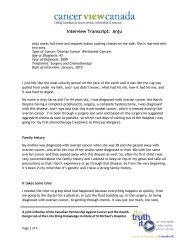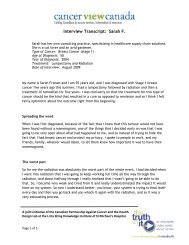A Guide to Implementing Best Practices in Person ... - cancerview.ca
A Guide to Implementing Best Practices in Person ... - cancerview.ca
A Guide to Implementing Best Practices in Person ... - cancerview.ca
Create successful ePaper yourself
Turn your PDF publications into a flip-book with our unique Google optimized e-Paper software.
Navigation: A <strong>Guide</strong> <strong>to</strong> <strong>Implement<strong>in</strong>g</strong> <strong>Person</strong>-Centred Care September 2012idea is <strong>ca</strong>lled a PDSA ramp. The team <strong>ca</strong>n implement PDSA ramps one after the otheror simultaneously.Below are the steps <strong>to</strong> follow <strong>to</strong> conduct a PDSA cycle:1) Gather your implementation team. Discuss your progress <strong>to</strong> date and some of thecurrent barriers or hurdles <strong>in</strong> your work. Select one of the most relevant problemsor hurdles and identify the purpose of the action that is needed <strong>to</strong> address it. Doesthe team need <strong>to</strong>:−−Develop a change idea (bra<strong>in</strong>s<strong>to</strong>rm <strong>to</strong> solve aproblem or conduct rapid cycles <strong>to</strong> gather <strong>in</strong>formationand address a problem)? The team knowsthere is a problem but is not sure how <strong>to</strong> addressit. Try a Defect Check Sheet or a Small Survey <strong>to</strong>isolate and identify the problem.Implement and test a change (take the steps <strong>to</strong>make a change and make sure that it worked). The team knows what needs <strong>to</strong>happen next, so it designs a small-s<strong>ca</strong>le modifi<strong>ca</strong>tion <strong>to</strong> implement systemati<strong>ca</strong>llyand measure <strong>to</strong> track the outcome. If the change appears <strong>to</strong> be successful,the change <strong>ca</strong>n be implemented on a larger and/or more complex s<strong>ca</strong>le.2) Use a PDSA Cycle worksheet <strong>to</strong> plan the rapid cycle.3) Communi<strong>ca</strong>te results early and often <strong>to</strong> all stakeholders.Teams identify thechange ideas and use aseries of PDSA cycles <strong>to</strong>develop and test smallchanges on a small s<strong>ca</strong>le<strong>in</strong> different contexts.PDSA Cycle Steps (Health Quality Ontario, 2012)Step 1: Plan State the purpose of the PDSA:P• Are you develop<strong>in</strong>g a change idea, test<strong>in</strong>g a change or implement<strong>in</strong>g change?• What is your change idea?• What <strong>in</strong>di<strong>ca</strong><strong>to</strong>r(s) of success will you measure?• How will data on these <strong>in</strong>di<strong>ca</strong><strong>to</strong>rs be collected?• Who or what is the subject of the test?• How many subjects will be <strong>in</strong>cluded and over what time period?• What do you hypothesize will happen and why?Step 2: Do• Conduct the test• Document results, <strong>in</strong>clud<strong>in</strong>g problems and un<strong>in</strong>tended consequencesD• Collect and beg<strong>in</strong> analysis of the dataStep 3: StudySStep 4: ActA• Complete analysis of the data and study the results• Compare the data <strong>to</strong> your predictions• Summarize and reflect on what was learned• Ref<strong>in</strong>e the change idea based on lessons learned from the test• Prepare a plan for the next test47













